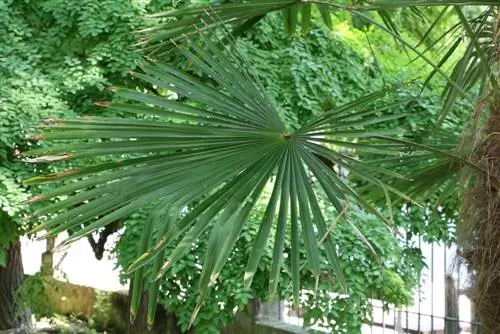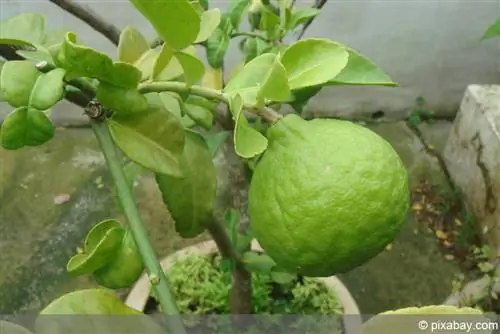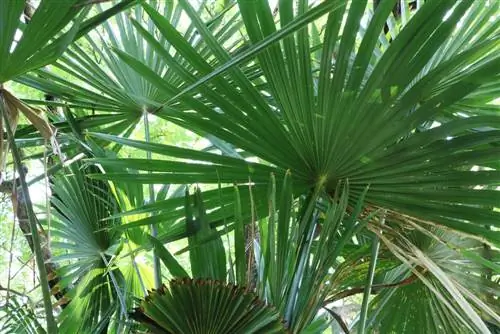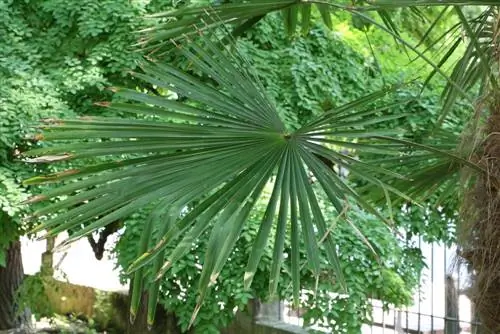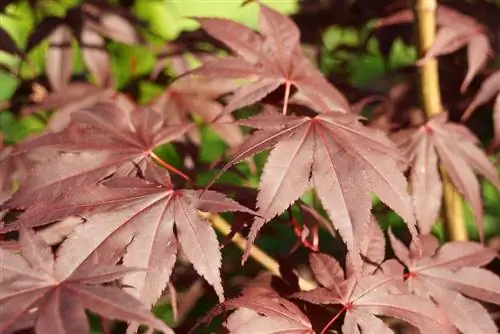- Author admin [email protected].
- Public 2023-12-17 03:39.
- Last modified 2025-06-01 06:48.
Characteristic of the Trachycarpus palm, which is native to the Asian high mountains, are its fan-shaped, long-stemmed leaves. The trunk is covered with fine or coarse fibers that fall off over the years. Hemp palms can be planted out in the garden or kept in pots, although specimens in pots have different wintering requirements.
Winter hardiness of the hemp palm Trachycarpus
If you want to keep a palm tree outdoors in Germany, you inevitably have to pay attention to good winter hardiness. The hemp palm Trachycarpus particularly stands out here. It originally grows in mountainous regions with a very harsh climate, at altitudes of 2500 m above sea level. Here these plants are subject to strong temperature fluctuations and are also exposed to the most adverse conditions.
The Chinese hemp palm (Trachycarpus Fortunei var Tesan), which is also the best known and most popular type of hemp palm, has the best winter hardiness of up to -17 degrees. Other subspecies still tolerate temperatures between -7 and -13 degrees. How winter-hardy a hemp palm actually is depends on the location, the age of the palm and its size. Even young hemp palms and specimens in pots are usually only partially hardy.
In addition, the number of winters that they have already spent outdoors also plays a role in the winter hardiness of individual plants, even at higher temperatures below zero. The better they are used to the frosty climate orThe later you plant them outdoors, the better they will cope. In general, it is advisable to overwinter hemp palms that are younger than 4 years and significantly smaller than 100 cm indoors.
Winter protection starts with planting
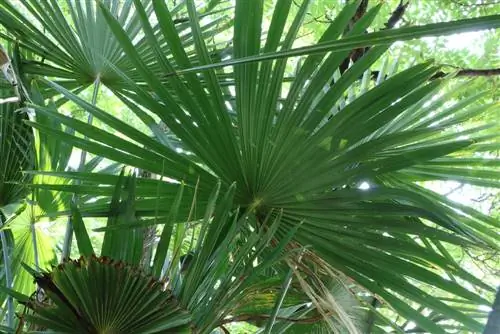
Winter protection doesn't just start with the first freezing temperatures, but right from the planting stage, with choosing the right location. The condition of the soil is no less important.
- Location should be protected from the wind
- Ideally in front of a south-facing house wall
- Climatic conditions are best here
- Make sure the soil is well-drained
- Soil must not become waterlogged even during continuous rainfall
- As a preventative measure, it is best to add a drainage layer to the planting hole
- Drainage should be 10 - 15 cm thick and made of coarse materials such as gravel
- Mix loamy soils with plenty of coarse sand for better permeability
Even if the location and soil conditions outdoors are optimal, you should neither apply winter protection too early nor leave it on the plant for too long. Only when persistent frost and temperatures below minus 5 degrees are expected is it time to provide the hemp palm with appropriate protection. As soon as it gets milder again, around March, this should be removed again.
Wintering in the garden
When it comes to properly protecting planted hemp palms, you should first know that winter moisture is much more threatening to these plants than frost. This especially applies to the root area and the sensitive heart of the plant. Nevertheless, they are quite robust and with a little help they can survive many winters unscathed.
Protect the root area and trunk
When temperatures drop below -5 degrees, both air and ground, it is time to take protective measures. First, the root area is covered with a cover. This can be a humus layer consisting of dry leaves and compost or bark mulch. The cover should be about 30 cm thick to prevent the ground from freezing completely. In particularly cold winters and at temperatures below -12 degrees, it is advisable to also protect the trunk. You can do this by wrapping it with several layers of fleece, jute or burlap.
Tip:
As an alternative to a cover made of leaves and brushwood, you can also protect the roots and trunk from freezing with a so-called palm heater.
Palm tree heating against extreme frosts
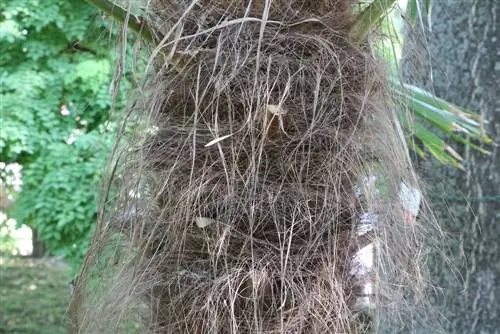
A palm heater is a special plant overwintering system in the form of a heating cable. This can be used both in the root area and to protect the trunk.
- To protect the root, bury the heating cable around the root area
- Then connect the cable to the power supply
- First wrap the trunk with a reed mat
- Then wrap the heating cable in a spiral shape from below over this mat
- Then secure the cable with adhesive tape to avoid slipping
- Wrap jute, fleece or a similar, breathable fabric over it
- Avoid direct contact of the heating cable with the trunk if possible
If the temperatures reach extremes below zero, the hemp palm can also be wrapped with foil. However, it should be removed as soon as the weather conditions improve and the temperatures rise again.
Protect Heart of the Hemp Palm
The most sensitive part is undoubtedly the heart of the Trachycarpus. Here, in the vegetation point, the palm tree forms new fronds. If too much water gets in here and freezes, the resulting ice crystals can damage the tissue of the young fronds, especially at the leaf bases. If the temperatures rise, the dead tissue can rot and destroy the entire palm heart, the plant dies.
From a temperature of -12 degrees, the palm fronds are usually frozen. If you then touch the unprotected fronds, for example to shake the snow off the leaves, the fine capillary channels in the leaves can break. This means that plant sap can no longer be transported through this capillary in spring and the damaged frond dies.
The best way to protect the heart and leaves is to loosely tie the fronds up with a rope or rope. It is better to avoid using wire for tying as it could cause damage to the leaves. In the event of prolonged precipitation, whether rain or snow, additional moisture protection in the form of a foil cover is recommended.
The foil must under no circumstances be closed at the bottom to avoid the formation of condensation. To prevent the cover from being blown away by the wind, you can weigh it down with two smaller stones attached to the bottom of the film. If the weather improves, the film must be removed.
Tip:
The palm fronds should be dry when you tie them up. You should also choose a day with dry weather for this campaign.
Wintering indoors
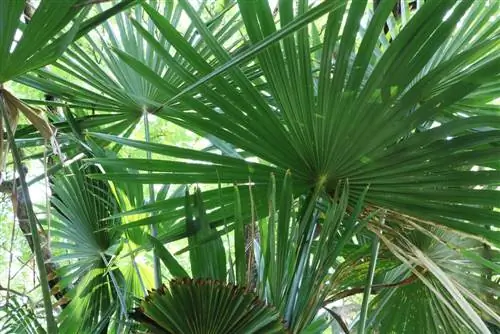
Hemp palms of the genus Trachycarpus should not be planted in the garden until they are 3 - 4 years old at the earliest. Only then are they robust and large enough to survive a normal winter outdoors, of course with appropriate protection.
- Specimens that are younger are better overwintered in a bucket frost-free
- Put plants away as soon as outside temperatures drop to -5 degrees at night
- Winter quarters should be bright and cool
- Temperatures ideally between 5 and 10 degrees
- The cooler the room, the darker the hemp palm can be
- Temperature fluctuations should be avoided if possible by changing the settings several times
- Overwintering older palm trees in pots, in mild locations also possible outside
- They tolerate temperatures of - 6 degrees
- Good frost and moisture protection is particularly important here
- Plants in pots are generally more sensitive to frost
- Location in front of a protected and shady house wall recommended
To protect against frost and moisture from below, place the bucket on a Styrofoam plate, a wooden pallet or something similar. The bale is covered with a thick layer of leaves and pine twigs and the bucket is wrapped several times with fleece or reed mats and also with bubble wrap. If the temperatures continue to fall, it is better to overwinter an older palm tree indoors.
Care in winter
Planted hemp palms need to be watered every now and then in winter, but only sparingly and only on frost-free days. Plants that do not survive the winter are often dried out and not frozen. However, you should avoid fertilizer completely. If you overwinter indoors, pest infestation can quickly occur due to the dry air. To prevent this, it can be helpful to occasionally spray the plants with lukewarm water. Before moving outdoors the following spring is a good time to repot a Trachycarpus, if necessary.

